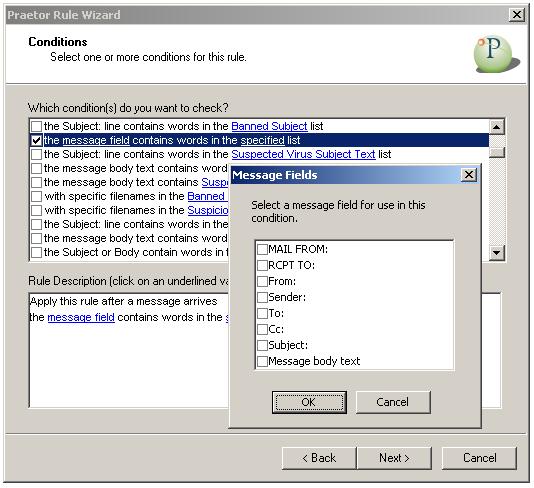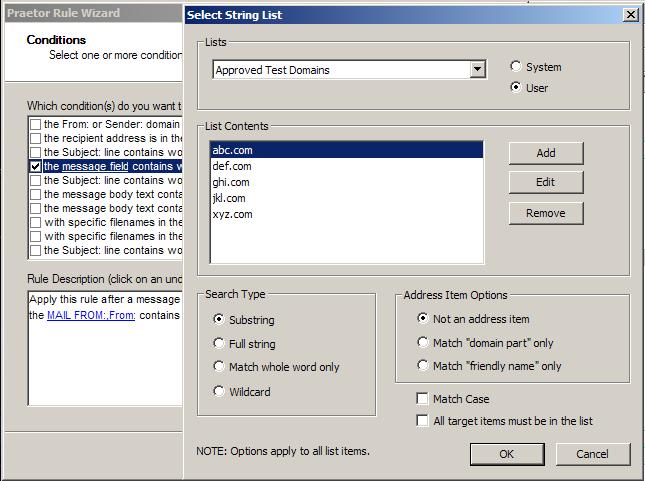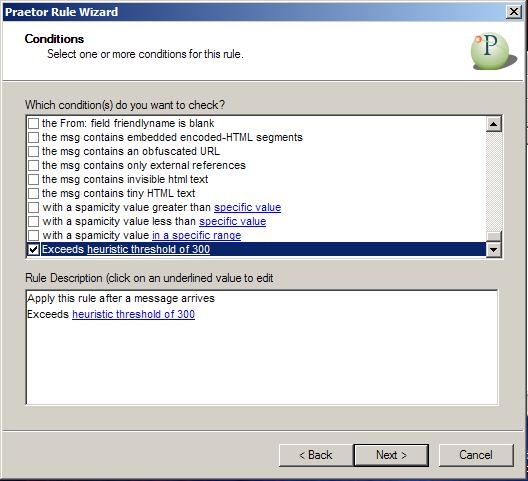
Praetor is supplied with dozens of different conditions for you to use alone or in combination. They were created after considering what are the typical conditions you might want to use.
The list below shows the conditions, named as they would appear for selection. Anything requiring further entry (e.g. list or message header field) are shown as in this font and color while comments are shown in this font and color.
|
In/Out |
Condition |
|
Inbound |
the From: field address is in the Accepted
Senders list |
|
Inbound |
the Sender: field address is in the Approved Senders list |
|
Inbound |
the From: or Sender: field address is in the Approved Senders list |
|
Inbound |
the From: or Sender: domain is in the Approved Domains list |
|
Inbound |
the From: or Reply-To: address is in the Approved
Listserver Addresses list |
|
Inbound |
the recipient address is in the Approved
Local Address list |
|
Inbound |
the recipient address is NOT in the Approved Local Address list |
|
Inbound |
the From: or Sender: address is in the Suspicious Senders list |
|
Inbound |
the From: or Sender: friendlyname is in the Suspicious Friendlyname Senders list |
|
Inbound |
the From: or Sender: domain is in the Suspicious Domain list |
|
Both |
the recipient address is in the Banned Recipients list |
|
Both |
the Subject: line contains words in the Banned Subject list |
|
Both |
the message field contains words in the specified list Used with new ability to create your own user list as described below |
|
Both |
the Subject: line contains words in the Banned Virus Subject list |
|
Both |
the message body text contains words in the Banned message text list |
|
Both |
the message body text contains Suspected Virus Message Text list |
|
Both |
with specific filenames in the Banned Attachment list |
|
Both |
with specific filenames in the Suspicious Attachments list |
|
Both |
the Subject: line contains words in the Banned Profanity list |
|
Both |
the message body text contains words in the Banned Profanity list |
|
Both |
the Subject or Body contain words in the Banned Profanity list |
|
Inbound |
the X-Mailer: field contains words in the
Bulk
Mail Program Signatures list |
|
Both |
the From:, Sender:, To: or Cc: address is in the Competitor's Domains list |
|
Both |
the From:, Sender:, To:, or Cc: address is in the Former Employee Address list |
|
Both |
the Subject or Body contain words in the Banned Confidential Information list |
|
Both |
the 821 To: address is in the Former Employee Address list |
|
Both |
the message body text contains words in the Variable info in message text list |
|
Both |
with specific words in the From: field |
|
Both |
with specific words in the Sender: field |
|
Both |
with specific words in the From: or Sender: field |
|
Both |
with specific words in the Reply-To: field |
|
Both |
with specific words in the To: field |
|
Both |
with specific words in the Cc: field |
|
Both |
with specific words in any recipient address |
|
Both |
with specific words in any address field |
|
Both |
with specific date string in the Date: field |
|
Both |
with specific words in the Subject: line |
|
Inbound |
with specific words in any Received: field |
|
Both |
with specific filenames as attachments |
|
Both |
with specific words in the Message-ID: field |
|
Both |
with specific words in any Precedence: field |
|
Both |
with specific words in any X- field |
|
Both |
with specific words in any List- field |
|
Both |
with specific words in the message body |
|
Both |
with specific words in the Subject: or message body |
|
Both |
with specific words in any message header field |
|
Inbound |
with failed DNS lookup on From: domain |
|
Inbound |
with failed DNS lookup on Sender: domain |
|
Inbound |
with failed DNS lookup on Reply-to: domain |
|
Inbound |
with DNSBL entry of CIP |
|
Inbound |
with failed DNS lookup on any replyable sender domain |
|
Both |
with specific words in the entire message (excluding msg headers) |
|
Inbound |
the 822 headers contain 8-bit data |
|
Both |
with Banned
msg body words in the entire message (excluding msg headers) |
|
Both |
the 821 headers contain 8-bit data |
|
Inbound |
the Subject or Body contains 8-bit data |
|
Inbound |
sender address is suspicious |
|
Both |
the Subject or Body contain words in the Weighted
sex-related list with threshold of 200 |
|
Both |
the message body text contains words in the
Weighted
advanced fee fraud list with a threshold of 200 |
|
Both |
the message body text contains words in the
weighted
drug solicitation list with a threshold of 200 |
|
Both |
with specific
weighted words in the Subject or Body |
|
Both |
the Body contains URL domains in the Banned
URL domains list |
|
Inbound |
there are no local To: or Cc: recipients |
|
Both |
the From: and To: addresses are the same |
|
Both |
the To: field is missing or blank |
|
Both |
the To: field exists |
|
Both |
the Cc: field is missing or blank |
|
Both |
the Cc: field exists |
|
Both |
the From: field is missing or blank |
|
Both |
the From: field exists |
|
Both |
the Precedence: field has bulk |
|
Both |
the Message-ID: field exists |
|
Both |
the Message-ID: field does not exist |
|
Both |
the Message-ID: field is blank |
|
Both |
with a (raw message) size in a specific range |
|
Both |
Containing attachments |
|
Both |
Containing only 1 To: recipient |
|
Both |
Containing no attachments |
|
Both |
Containing over 20 RFC822 To: recipients |
|
Both |
Containing over 20 RFC821 To: Recipients |
|
Both |
Containing a single RFC821 To: Recipient |
|
Both |
the message has Bcc recipients |
|
Both |
with specific addresses in the 821 From: field |
|
Both |
with specific addresses in the 821 To: field |
|
Both |
the Subject: field is missing or blank |
|
Both |
check EXCEPTIONS only |
|
Inbound |
with a connecting IP in a DNS blacklist |
|
Both |
the From: friendlyname is in the Expletive
Friendlyname list |
|
Both |
the Subject or Body contain words in the Expletive
list |
|
Both |
the Subject or Body contain words in the Spam list |
|
Both |
the Subject: line contains words in the Suspicious
Characters list |
|
Both |
the message body text contains words in the
Opt-Out
list |
|
Inbound |
the From: field friendlyname is blank |
|
Inbound |
the msg contains embedded encoded-HTML segments |
|
Inbound |
the msg contains an obfuscated URL |
|
Inbound |
the msg contains only external references |
|
Both |
the msg contains invisible html text |
|
Both |
the msg contains tiny html text |
|
Inbound |
with a spamicity value greater than specific
value |
|
Inbound |
with a spamicity value less than specific
value |
|
Inbound |
with a spamicity value in
a specific range |
For a table of the various lists used by some of these conditions, click here.
One condition in the above table is called "the message field contains words in the specified list" and is a very special condition. It is the only condition that has two selections, and it allows you to select what field to check against a specified list including any newly-created user list. Thus it is essentially a custom condition that demonstrates Praetor's flexibility to create many different rules.
When this condition is chosen, and you click on the message field selector, the following dialog box appears on your screen.

Once you have selected the field(s), clicking on the list selector in the Rule Description window will then display the following screen.

The drop-down list will show all available lists, and you may choose to display the system-internal or user-created lists. Once a list is selected, the contents are displayed below.
Click the following links for more information on:
If the message field being tested in the condition is an address field, then the appropriate button may restrict the search to the domain portion of the address, or the friendly or displayable name associated with the address.
You may also restrict the search through the list to enforce the case of characters. By selecting All target items must be in the list, you will require that every item found in the field being searched must be found in the list, a very important restriction employed in the defense against the Reverse NDR attack.
One condition is used specifically for creating a rule that implements heuristic filtering based upon a score computed using weights for spam characteristics found within the message. This is the condition labeled "Exceeds heuristic threshold of 300" as shown below.

Selection of this condition will set a threshold for the computed heuristic score with 300 as the default value. If the enabled tests cause the overall message to score a value that exceeds this threshold, then the specified action will be taken.
You may change the threshold value by clicking on the link in the lower window and you will be presented with the following screen.

Change the value either by typing the number in the numeric field or
moving the horizontal slider bar, and press  .
.